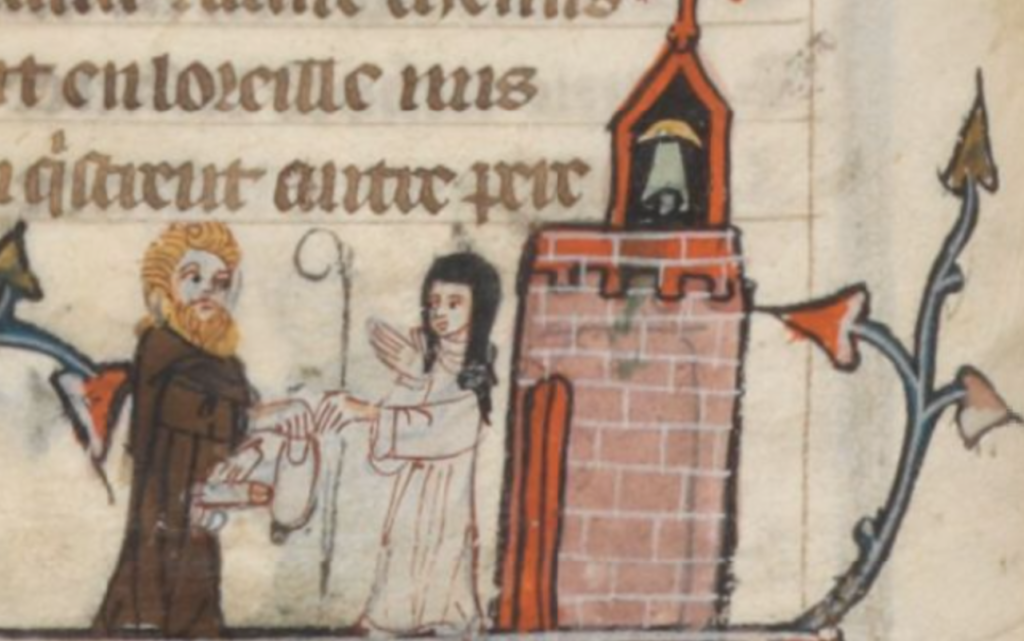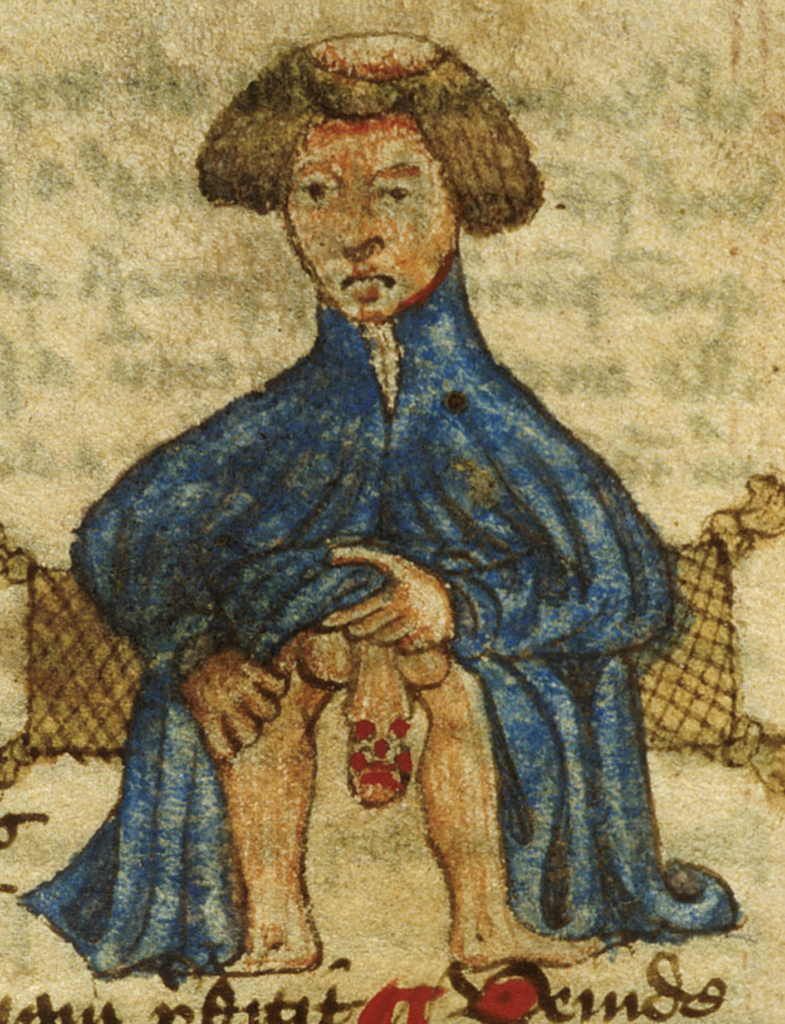Katherine Harvey
In an anonymously-authored late medieval English poem called ‘A Talk of Ten Wives on Their Husbands’ Ware’, a group of women gather in a tavern to grumble, in graphic detail, about their husbands. Some of these men are impotent, and none of them provide sexual satisfaction to their lustful spouses. Several of the women complain that their partners have very small genitals: one compares her husband’s manhood to a maggot, while another claims that her smallest finger is larger than her husband’s erect penis (‘The leste fyngere on my honde / Is more than he, whan he dothe stonde’).

In fact, medieval literature is littered with women obsessed with male genitals, the bigger the better. Amongst the many bawdy stories in the fifteenth-century Burgundian collection The Hundred New Tales, for example, is that of a woman who plots unsuccessfully to have sex with her husband’s friend, an innkeeper on Mont St Michel, who has ‘the most finely crafted, handsome, and thickest member in the whole region. So proficient was he with it that four, five or even six times…cost him no more effort than if he had undone his hood.’
And The Blacksmith of Creil (a French verse dating from the long thirteenth century) tells a similar story. One day, the title character sees his servant urinating, and is amazed by the youth’s enormous penis, ‘two palms in length, wide as a fist.’ He knows that, if his wife found out about their well-endowed employee, ‘she’d sooner have been dead and buried / than not secure herself a share.’ So he tells her about it in great detail, claiming that ‘I’ve never seen a larger member.’ She pretends to be disgusted, but as soon as her husband goes out, she propositions the servant. Unfortunately, her spouse has tricked her, and is actually hiding in the house. He jumps out, dismisses the servant, and beats his wife.
Whilst such gendered stereotypes were often played for laughs in medieval fiction, real-life women were widely thought to share the predilections of their fictional counterparts. The anonymous Spanish author of a fifteenth-century Mirror of Coitus claimed that ‘From an experienced woman I learned the characteristics that women desire in men. These are: a good member, a large and hard penis, and an abundance of sperm.’ Such attitudes could have serious consequences in the real world, where both men and women were judged for their physical attributes and sexual capabilities.
A man’s penis would be subjected to particular scrutiny if his wife sought to have their marriage annulled on grounds of sexual incompatibility, although a woman who claimed that she could not be penetrated by her husband because his penis was too big was unlikely to receive a favourable verdict. The Dominican canonist John of Freiberg (d. 1314) claimed to have been told by a wise woman that a man’s penis was never so large that his bride could not accommodate it, and thus did not consider this to be a valid reason for invalidating a union. Instead, it seems to have been assumed that force was the solution in such cases. A wife might, however, secure an annulment if her husband was impotent.
The case of Katherine Barley vs. William Barton provides a particularly colourful account of the intimate examinations which this could require. Over the course of several months in the early 1430s, thirteen deponents – all local men and women of good standing, at least some of them known to the couple – recounted their inspections of Barton to the archbishop of York’s court, and all reported that he seemed capable of having sex. Emmota Garde, a widow, examined his genitals and compared them favourably to those of her late husband, by whom she had seven children. Matilda Leeke judged his penis and testicles ‘sufficient to serve and to please any honest woman.’ Several men also testified to having seen and touched his erect penis during one of these examinations, including Robert Lincoln, a tailor, who felt William’s ‘manly yard, long and large enough to have carnal knowledge of any woman living.’ John de Metelay admitted that William’s penis was ‘longer and larger’ than his own. These statements helped William to prove his potency – the only medieval English husband who is known to have done so – and so the couple were obliged to remain together.
The assertions of several witnesses in this case make clear the medieval tendency to link large genitalia with the ability to father children, an idea which was also discussed in medical texts. Contrary to popular belief, medieval people recognised that infertility was not always a female issue, with male problems in this department often being linked to penis size. Yet in this respect, bigger was not always better, for while a very small penis could not send the semen far enough, a very long penis meant that the generative spirit of the seed was weakened by the time it reached the end. It was therefore very important that a man chose a partner whose genitals were compatible with his own: a man with a short penis needed a small woman, whereas a man with a long penis should marry a big woman with long thighs.

Fortunately, if a couple who were already married turned out to be incompatible in this way, there were things they could do to tackle the problem. The French physician Bernard of Gordon (fl. 1270-1330) explained that:
If it is because of shortness of the penis, then the woman’s thighs should be lifted so the seed can fall into the depth of the natural field, or the penis should be magnified in this way: it should be beaten gently with rods and plastered with pitch…If the sterility is because of the excessive length of the penis then the man or woman should hold the root of the penis tightly with his or her whole hand, both so that the whole penis is not put inside and so that the seed does not grow cold on the way.
Such concerns legitimised the inclusion of preparations which claimed to enlarge the penis in medical treatises: chopped earthworms mixed with jujube oil, rubbed into the penis and left on overnight, or ground leeches mixed with jujube oil, were just two examples. Washing the penis several times a day with warm sheep’s milk or hot water and oil was supposed to achieve the same result.
Of course, we cannot rule out the possibility that some men used these remedies for non-procreative purposes. Perhaps they wanted to be more like the fourteenth-century Welsh poet Dafydd ap Gwilym, whose poem ‘The Penis’ is narrated by a man with a member ‘longer than a big man’s thigh.’ That real medieval men were bothered by the size of their private parts is also strongly suggested by a drawing found in the margins of a thirteenth-century English legal document. This sketch of two penises – one small, and one much larger – is labelled ‘My lord’s is like this [next to the smaller organ] but Gerard’s is like this [next to the more impressive specimen].’
Given that the potential consequences of having a very small penis ranged from infertility to public humiliation, it is not hard to understand why some men might have resorted to one of the revolting remedies suggested by the medical texts – just as some medieval women applied ointments and bound their chests in pursuit of the small, pert breasts which were the medieval ideal. Penis enlargement spam may have been a late twentieth-century innovation, but it seems that the ideals and insecurities behind it are much older.
 Katherine Harvey is a medieval historian based at Birkbeck, University of London. She is the author of Episcopal Appointments in England, c. 1214-1344 (Ashgate, 2014), and The Fires of Lust: Sex in the Middle Ages (Reaktion, 2021). She tweets from @keharvey2013
Katherine Harvey is a medieval historian based at Birkbeck, University of London. She is the author of Episcopal Appointments in England, c. 1214-1344 (Ashgate, 2014), and The Fires of Lust: Sex in the Middle Ages (Reaktion, 2021). She tweets from @keharvey2013

NOTCHES: (re)marks on the history of sexuality is licensed under a Creative Commons Attribution-NonCommercial-NoDerivatives 4.0 International License.
Based on a work at www.notchesblog.com.
For permission to publish any NOTCHES post in whole or in part please contact the editors at NotchesBlog@gmail.com





I feel bad for the women who were told to bear large penises .
Those who had to deal with the forceful approach yes indeed. That’s such a loss for all parties involved though…. If they had husbands who were thoughtful or attentive, who aroused their wives with intimate attention and foreplay and took it nice and slow, there would’ve been no problems with big packages, and both partners would have had a better time.
I do have to say I enjoyed ‘The leste fyngere on my honde / Is more than he, whan he dothe stonde’ as my husband is…..
Ah we all keep denying that size matters but it doth seem that the truth has been known for centuries.
‘He should be bigger than any fyngere whan he dothe stonde’
Thank you for an entertaining read.
x M
Writing a bit after the close of the medieval period, Shakespeare included many clever and witty references to penis size in his plays, with characters having small members always being at the disadvantage. The examples from medieval literature in this article are delightful. They’re part of a clear thread woven into the fabric of Western literature from ancient Rome to the current day, and they reflect the unmistakable sense among both men and women generally that men with large penises (and their partners) enjoy an advantage, and men with smallest of penises fall somewhere between disappointing and laughable. It is interesting that, in many examples from the medieval period, male sexual adequacy and penis size aren’t just whispered about but considered common knowledge and openly discussed.